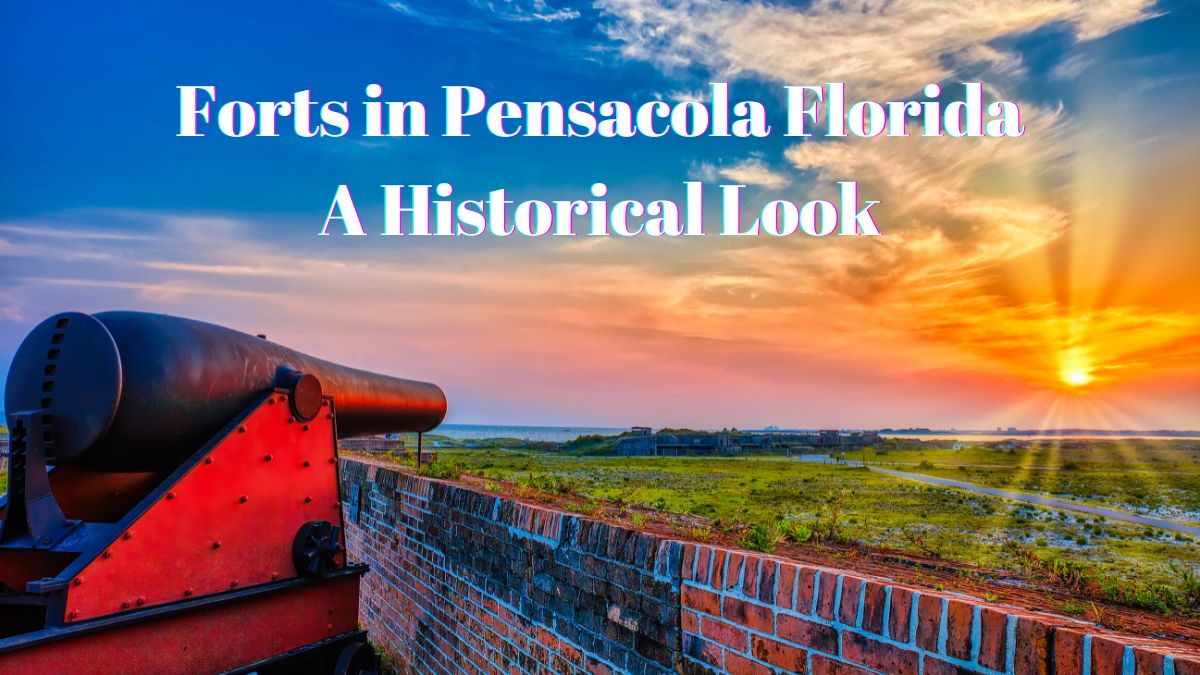Pensacola, Florida, has a rich military history with many historic forts that played essential roles in various conflicts. These notable sites are Fort Barrancas, Fort McRee, and Fort San Carlos de Barrancas.
These forts served as critical defense points during the Civil War and World War II, witnessing battles between Confederate and Union forces and later being managed by the National Park Service.
Situated near the Gulf of Mexico, these forts are part of the Gulf Islands National Seashore and provide visitors with a glimpse into the past. The Pensacola Bay area was once a battleground for Spanish, French, and British forces before coming under United States control.
Today, tourists to the downtown Pensacola area can explore historical sites and learn about the significance of these forts in American military history.
The military history is vast and fascinating, from the Battle of Santa Rosa Island and Confederate troops maintaining control in the Pensacola area to the Union Army overtaking these Southern forts.
Visitors to these historic landmarks can appreciate their strategic importance and marvel at their impressive masonry and the progress of history throughout their existence.
Historical Background of Forts in Pensacola, Fl.
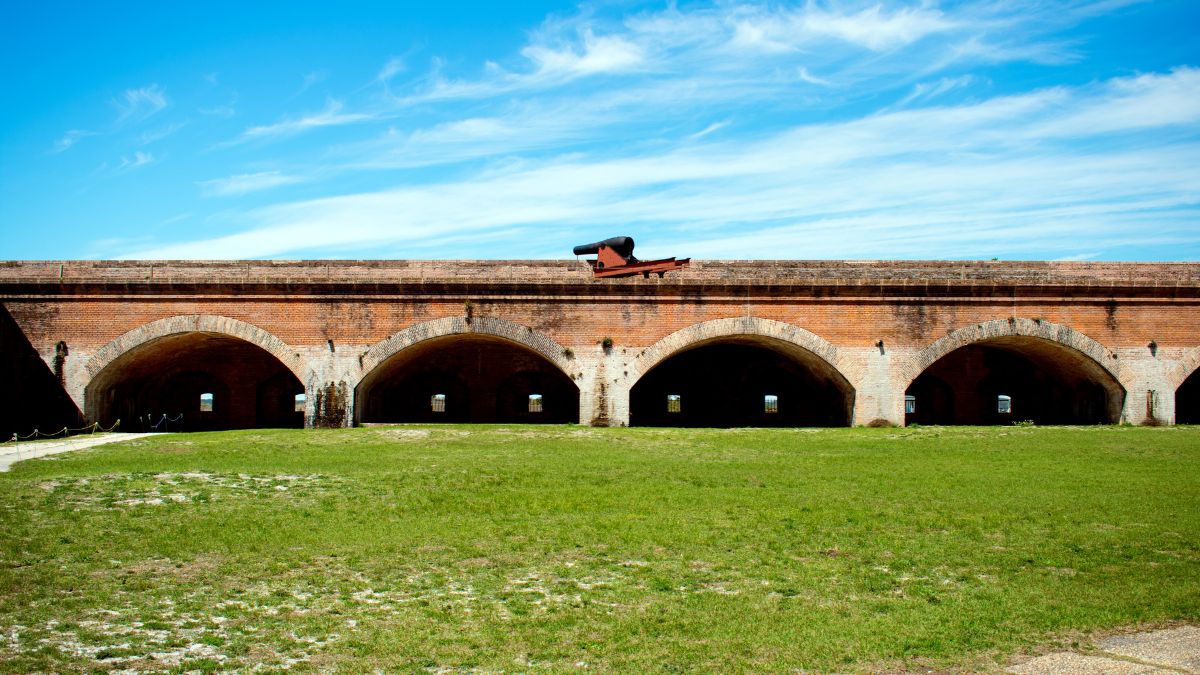
Spanish Influence
Pensacola, Florida, has a history of over 450 years, with its strategic location on the Gulf of Mexico making it a focal point for various European powers. The Spanish were the first to establish a settlement in the Pensacola area in 1559.
Spanish forts were built to protect the settlers and the valuable port, including Fort San Carlos de Austria and Bateria de San Antonio. Spanish control in Pensacola persisted until the early 18th century, apart from a brief period of French occupation between 1719 and 1722.
British Occupation
In 1763, due to the Treaty of Paris that ended the French and Indian War, control of Pensacola passed to the British. Eager to assert dominance, the British constructed several new forts, such as Fort George and the Royal Navy Redoubt, solidifying their presence in the Gulf Coast region.
Pensacola became a critical strategic location for Britain during the American Revolution, but Spanish forces, in alliance with the American revolutionaries, captured the city in 1781.
American Control
Following the American Revolutionary War, Spain returned control of Pensacola to Britain in 1783. However, just a few decades later, in 1819, Spain ceded Florida to the United States. As a result, American forces, led by General Andrew Jackson, took over Pensacola and its forts.
Under United States control, many new forts were built as part of the country’s coastal defense strategy. Some of these forts include Fort Barrancas, Fort McRee, and Fort Pickens, which became integral to the defense of Pensacola Bay.
These forts played significant roles during the Civil War, with Confederate forces attempting to regain control of them from Union forces.
During World War II, the Pensacola forts continued to play a vital role in national defense. The United States utilized the forts, alongside the newly established Pensacola Naval Air Station, to train military personnel and safeguard the Gulf of Mexico.
Today, many of these historic forts are preserved by the National Park Service as part of the Gulf Islands National Seashore, providing visitors with a glimpse into the region’s history and military heritage.
Major Forts in Pensacola, Fl.
Fort Pickens
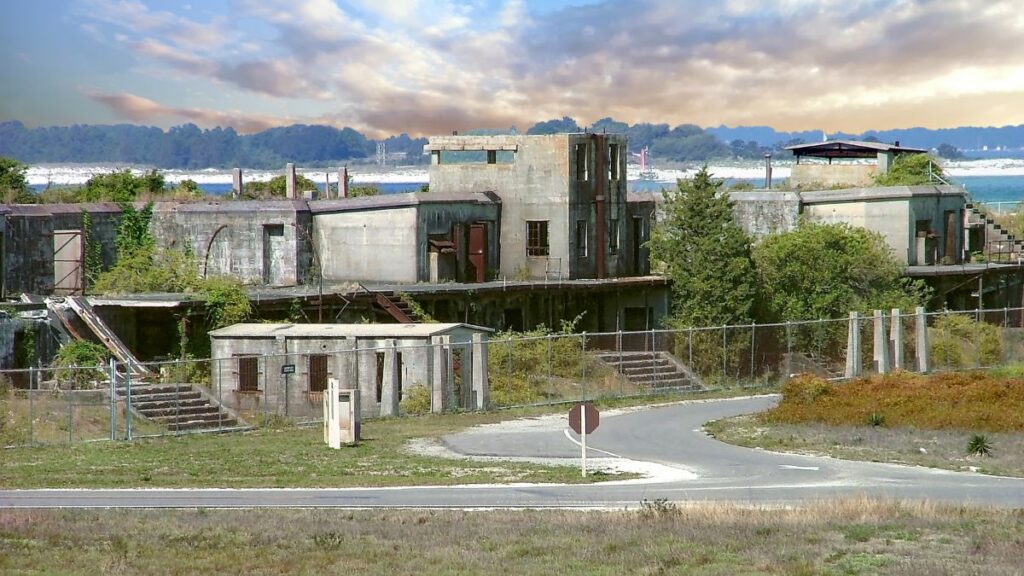
Fort Pickens, located on the western end of Santa Rosa Island, is a historic military fort in Pensacola Bay. Established in 1834 as part of the United States’ coastal defense strategy, it protected the Pensacola Navy Yard.
Fort Pickens played a significant role during the Civil War as it remained under Union control, despite Confederate forces attempting to capture it. Today, Fort Pickens is part of the Gulf Islands National Seashore, managed by the National Park Service.
Visitors can explore this historic fort’s grounds, battery installations, and ruins. The site also offers recreational activities such as:
- Self-guided tours
- Camping at designated campsites
- A visitor center with exhibits on the fort’s history
Fort Barrancas
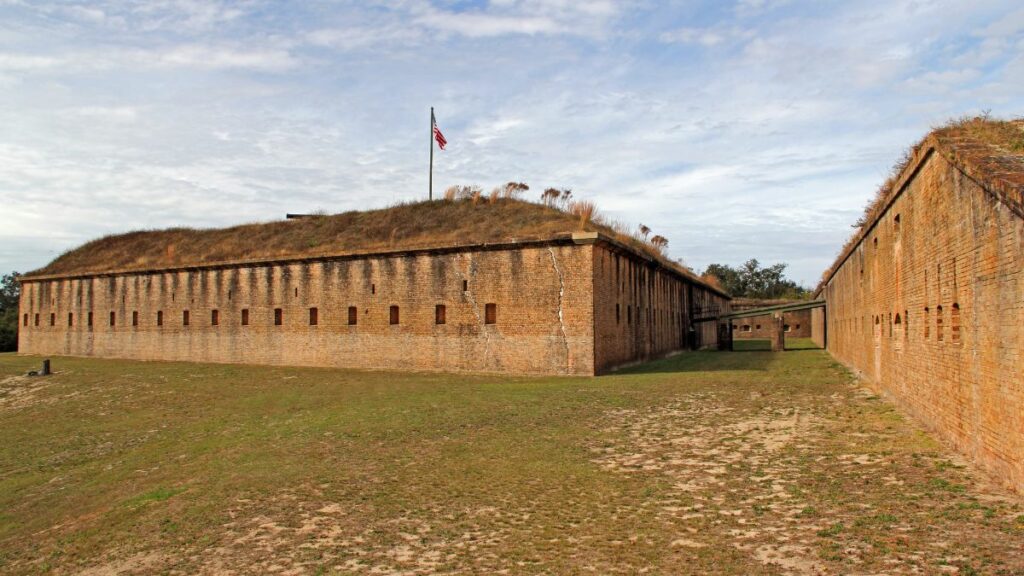
Overlooking Pensacola Bay, Fort Barrancas is situated on the grounds of the Pensacola Naval Air Station. The fortification’s history spans over 200 years, with origins dating back to the Spanish Water Battery built in the late 18th century.
Fort Barrancas was designed by the Army Corps of Engineers and completed in 1844. It was a crucial coastal defense during the Civil War and was later decommissioned after World War II.
Notable features of Fort Barrancas include:
- Bateria de San Antonio, a reconstructed Spanish battery
- Confederate and Union forces’ battle sites
- Tours and exhibits operated by the National Park Service
Fort McRee

Fort McRee, located on the eastern tip of Perdido Key, was constructed between 1839 and 1843 to protect Pensacola Bay’s entrance. Unfortunately, much of Fort McRee was destroyed during the Civil War, and what remains today are ruins and fragments of its former glory.
Access to the fort’s remnants is challenging due to its isolated location within the Gulf Islands National Seashore. However, visitors can view the fort from afar at the Naval Live Oaks Area or by boat.
Advanced Redoubt
The Advanced Redoubt, located near Fort Barrancas, was built between 1845 and 1870 to add extra protection for the nearby Pensacola Navy Yard. Constructed with brick and earthwork, the redoubt consists of a dry moat, gun emplacements, and a parade ground.
Visitors can access the Advanced Redoubt through the Fort Barrancas Visitor Center, part of the Gulf Islands National Seashore.
Related: Forts in St. Augustine
Military Significance of Forts in Pensacola, Fl.
The Civil War
Fort Barrancas, located on Pensacola Bay, played a crucial role in the American Civil War. The Union and Confederate forces sought to gain control of Pensacola Bay due to its strategic importance in the Gulf of Mexico. Initially, Confederate troops occupied the fort, but Union forces’ persistent attacks led to Confederate soldiers abandoning it.
Union Army took control over the Pensacola Navy Yard, fortifying Fort Barrancas, Fort San Carlos de Barrancas, and the nearby Fort Pickens area. The Battle of Santa Rosa Island and several artillery duels between Union and Confederate forces exemplified the struggle to control Pensacola Bay during the Civil War.
The War of 1812
During the War of 1812, the Pensacola area, including Fort San Carlos de Austria and Royal Navy Redoubt, was under Spanish control. They allowed British forces to use the city of Pensacola, posing a threat to the United States.
General Andrew Jackson led American forces to attack Spanish forts, ultimately capturing Pensacola and forcing British troops to abandon the region.
The Seminole Wars
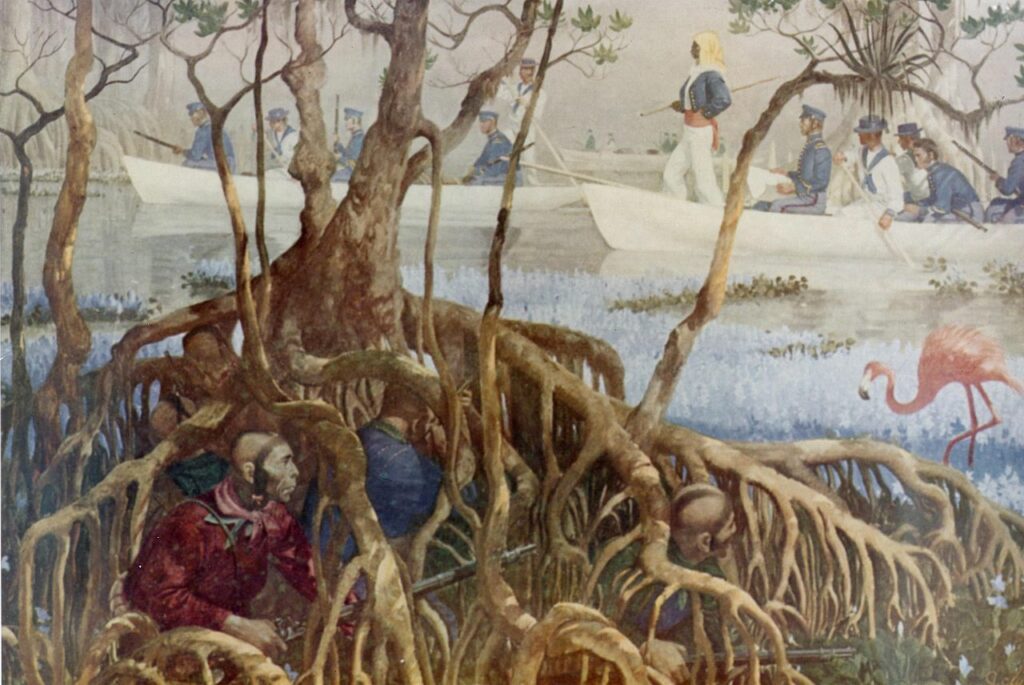
The Seminole Wars were a series of conflicts between the United States and Seminole tribes during the early 19th century. Forts in the Pensacola area played significant defensive roles during these battles.
Fort Barrancas was used as a base for U.S. soldiers fighting against the Seminoles in the region. Fort San Carlos de Barrancas also served as a key location for the military during the Seminole Wars.
Spanish-American War
As tensions between Spain and the United States escalated in the late 19th century, coastal defense became a priority for the U.S. government. The Pensacola area, including historic Fort McRee, was fortified to protect American interests in the Gulf of Mexico.
Fort Pickens, Fort Barrancas, and the Advanced Redoubt underwent improvements to remain functional and sufficiently defend the coast against potential Spanish attacks.
World War II
During World War II, Fort Barrancas and the Pensacola area played a role in America’s war efforts. While traditional forts were no longer relevant for modern warfare, these historic sites like Battery Worth and part of the Gulf Islands National Seashore housed American forces and served as training grounds for soldiers.
Pensacola Naval Air Station, situated in Escambia County, became a crucial site for military service during the war, housing thousands of U.S. soldiers and contributing to the war effort.
Related: Unveiling Historic Forts in Florida: An Epic Journey Through Time
Visiting Forts in Pensacola, Fl.
Gulf Islands National Seashore
Pensacola is known for its rich history of military forts, with several located within the Gulf Islands National Seashore. This national park includes historic sites like Fort Barrancas, Fort San Carlos de Austria, and Fort McRee.
These forts protected Pensacola Bay and the harbor during the Civil War, World War II, and earlier conflicts.
The Gulf Islands National Seashore stretches across parts of Florida and South Carolina, preserving military forts, trails, and pristine natural landscapes. Visitors can explore these forts and learn about their fascinating history as part of their visit to the Pensacola area.
Activities and Tours
There are various activities for visitors to engage in when exploring the forts. Self-guided and guided tours are available at the different forts, allowing guests to learn about the United States military history through informative guided walks or at their own pace with informational signs.
Visitors can explore the historic military fort and its fortifications at Fort Barrancas, like the advanced redoubt and the Spanish water battery. The Battle of Santa Rosa Island, a critical phase of the Civil War, can be recounted at Fort Pickens, while Fort McRee stands as a testament to the evolution of coastal defense systems.
Visitor Center
Each key fort within the Gulf Islands National Seashore has a nearby visitor center operated by the National Park Service.
These centers provide information, maps, and exhibits regarding the fort’s history, significance, and life during military operations. Visitors are also encouraged to browse the various displays, engage with park rangers, and ask any questions they might have.
Fees
Entrance fees for specific forts or parking areas within the Gulf Islands National Seashore might exist. However, some sites may not require visitors to pay for entry. To ensure proper preparation, checking each site’s entrance requirements on the National Park Service website before visiting is vital.
Architectural Features of Forts in Pensacola, Fl.

Brigadier General Simon Bernard
Fort Barrancas, located in Pensacola Bay, was designed by French Brigadier General Simon Bernard. He was a military engineer who significantly constructed masonry forts across the Gulf of Mexico and the Atlantic coastline.
Fort Barrancas, the Advanced Redoubt, and Fort San Carlos de Austria were part of the coastal defense line to protect Pensacola Harbor and the Pensacola Navy Yard.
Under the guidance of Bernard and General Andrew Pickens, the construction of Fort Barrancas included innovative techniques in design and materials.
The fort’s casemates featured vaulted ceilings for improved structural integrity, and it had hot shot furnaces to heat cannonballs before firing. The fortress layout provided a 360-degree range of fire, allowing the garrison to defend the entrance channel.
Cannons and Defensive Structures
The Pensacola area was an important military center in the United States, with several historic forts around the coastline. At Fort Barrancas, the Federation forces equipped the fort with various cannons and artillery, such as:
- Long-range guns for defending against enemy ships approaching Pensacola Harbor
- Mortars for attacking invading forces from the rear
The coastal defenses also included walls, moats, and towers to protect the fort from direct assault. The Confederate forces attempted to seize control over these forts during the Civil War, particularly in the Battle of Santa Rosa Island. Despite constant threats, Union forces maintained control, preserving the fort throughout the years of history.
The defense line ensured the safety of the Pensacola Navy Yard, which played a crucial role during World War II. Cannons and other defensive structures can still be seen today, and the National Park Service maintains these sites as part of the Gulf Islands National Seashore.
Garrison and Fortifications
Fort Barrancas housed a well-trained and equipped garrison to protect the Pensacola coastline. The garrison lived in sturdy barracks within the fort and was supported by other military installations in the Pensacola area, such as Fort Pickens and Fort McRee.
Fort Barrancas’ design also featured numerous defensive structures, including:
- Battery Worth: A reinforcement that guarded the western end of Santa Rosa Island
- Royal Navy Redoubt: Located at the southern part of Gulf Islands National Seashore, it defended against potential naval attacks
Furthermore, several Spanish forts in the area, such as the Spanish Water Battery, contributed to the layered defense strategy of the region. The combined strength of these fortifications and garrisons successfully protected Pensacola Bay and its strategically critical Navy Yard.
Pensacola’s Forts Today
Preservation Efforts
In Pensacola, Florida, efforts are being made to preserve and maintain the historic forts in the area. The National Park Service has taken charge of preserving and maintaining key sites like Fort Barrancas, Fort McRee, and the advanced redoubt of Fort San Carlos de Barrancas.
Additionally, the historic Fort Pickens is part of the Gulf Islands National Seashore and has become a significant tourist attraction.
The city of Pensacola is also keen on protecting the years of history found in sites such as the Spanish forts, the Pensacola Navy Yard, and the historic military forts, which were essential during the Civil War and World War II.
Educational Programs
Several educational programs have been set up to help visitors learn more about the rich history of Pensacola’s forts. The National Park Service provides several guided tours at Fort Barrancas, the advanced redoubt, the Pensacola Naval Air Station, and other historical sites.
These tours cater to various ages and learning experiences, from walking tours in downtown Pensacola to self-guided tours at the Fort Pickens Area and various campsites managed by the National Park Service.
The history of these forts is vast, covering various eras, such as the Spanish Water Battery period, the American Revolutionary War, and conflicts between Confederate and Union forces during the Civil War.
The forts have tales of American forces defending their positions against Confederate soldiers and European powers. They served as vital coastal defense and artillery installations, and their grounds have seen the progress of history shaped by American culture.
These educational programs support the city’s desire to maintain its strong ties to its military history and facilitate visitors’ understanding of the area’s rich heritage. As a result, tourists and residents can learn about the strategic positions of these forts in Pensacola Bay, the Gulf of Mexico, and the Escambia County area.
Conclusion – Forts in Pensacola, Florida
As you can see, Pensacola, Fl. has a rich military history and has defended the homeland for hundreds of years. If you are ever in the Pensacola area, visiting some of these historic forts would be well worth it. I hope you enjoyed this article, and if you have any questions or comments or have ever visited any of these forts, we would love to hear from you in the comment section below!

Cory is a website owner and content creator who enjoys fishing, history, coin collecting, and sports, among other hobbies. He is a husband and father of four.
Romans 15:4 For whatever was written in former days was written for our instruction, that through endurance and through the encouragement of the Scriptures we might have hope.

